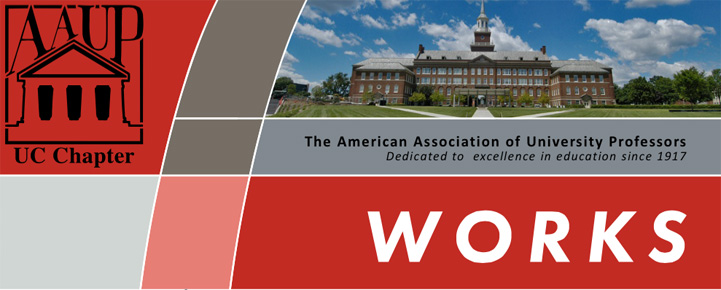Inside this issue:
- Click here to read 51%.
- Click here to read Budget 2021.
- Click here to read Faculty Spotlight.
- Click here to read Know Your Contract.
51%
 Since the onset of Performance Based Budgeting (PBB) in 2010, colleges have been experiencing a growing financial strain. In a February 2019 report, the Council of Deans highlights how the percentage of revenues retained by the colleges has changed since the implementation of PBB in the table below:
Since the onset of Performance Based Budgeting (PBB) in 2010, colleges have been experiencing a growing financial strain. In a February 2019 report, the Council of Deans highlights how the percentage of revenues retained by the colleges has changed since the implementation of PBB in the table below:

*Table from 2019 Council of Deans Report and was generated by data from the UC Chapter of the AAUP
In addition to declining revenue retention, the council of deans reports that over 31 costs have “trickled down” to the colleges. The cumulative effect of these additional costs and the growing threshold has created an untenable situation where over 5 colleges are in “debt” to the University. In the 2019 PBB Progress Tracking Report from July 16, 2019, the College of Law, the College of Design, Architecture, Art & Planning, College of Education, Criminal Justice and Human Services, College-Conservatory of Music, and College of Arts & Sciences “owe” the university in varying amounts for FY 2019 ranging from $29,916 to $782,714. The debts accumulate over the years and thereby, create a “rolling” debt which each college must continue to work on repaying. Over $8 million is still “owed” to the university from this “rolling” debt. Had the percentage of revenue retained by the colleges not dipped over time, the colleges could have easily absorbed these debts in FY 17 alone and still had a significant amount of money to put toward the primary mission of UC – education. The financial strain caused by the threshold and matriculating costs encourage decisions to be made that increase the use of part-time faculty, decrease the student services offered, increase class size, and overall weaken the quality of education at UC. With an all-time record-breaking number of students enrolled for the 6th year in a row, it is unfathomable how so many colleges can continue to operate on a crisis basis. As tuition and fees become a larger and larger revenue stream for the university and at the same time the number of high school students entering college is dropping, creating a budget that risks compromising the quality of a UC education is irresponsible. The time has come for UC to demonstrate that it prioritizes education by reallocating funds back to the colleges before irreparable damage to mission and reputation of the university occurs.
Budget 2021
 Every June at the Board of Trustee’s meeting, the UC administration presents its proposed budget for the upcoming fiscal year as well as boasts about the past year’s accomplishments. In tandem with this presentation, UC produces an 84 page budget book which is available at https://www.uc.edu/content/dam/uc/af/budgetfinsvcs/docs/20192020%20UC%20Budget%20Book%20Final%20Version.pdf. For Fiscal Year (FY) 2019-2020, the UC administration predicts a total revenue stream of $1.36 billion, which is a $51.6 million (3.6%) increase in revenues from FY 2018-2019. Approximately $48 million of the increase can be attributed to tuition & fees, auxiliary enterprises, grants & contracts, and sales & services. Expenditures will account for $1.24 billion, and another $108 million will go to debt service. An additional $10 million will be transferred to a variety of non-revenue generating entities. The budget is very tight and only leaves a little over $6 million (0.4%) in surplus. Expenditures increased by an average of 3.4%, but several expenses increased at a much higher rate. Auxiliary enterprises and public service budget lines increased by 15% and 8% respectively while student services and institutional support increased by 6.4% and 6.3% respectively. Instructional & general lagged behind the average at 2%. Future reserves, operations & management of the power plant, and academic support all saw a decrease to their budgets. In addition, a $1.32 million budget line was added for the Next Lives Here initiative. Although this budget line doesn’t account for all of the expenditures on Next Lives Here as much of it must be included in other budget lines. The budget book reports that UC has spent $21 million on the Next Lives Here initiative since its inception and projects that a total of $150 million over the next several years will be spent.
Every June at the Board of Trustee’s meeting, the UC administration presents its proposed budget for the upcoming fiscal year as well as boasts about the past year’s accomplishments. In tandem with this presentation, UC produces an 84 page budget book which is available at https://www.uc.edu/content/dam/uc/af/budgetfinsvcs/docs/20192020%20UC%20Budget%20Book%20Final%20Version.pdf. For Fiscal Year (FY) 2019-2020, the UC administration predicts a total revenue stream of $1.36 billion, which is a $51.6 million (3.6%) increase in revenues from FY 2018-2019. Approximately $48 million of the increase can be attributed to tuition & fees, auxiliary enterprises, grants & contracts, and sales & services. Expenditures will account for $1.24 billion, and another $108 million will go to debt service. An additional $10 million will be transferred to a variety of non-revenue generating entities. The budget is very tight and only leaves a little over $6 million (0.4%) in surplus. Expenditures increased by an average of 3.4%, but several expenses increased at a much higher rate. Auxiliary enterprises and public service budget lines increased by 15% and 8% respectively while student services and institutional support increased by 6.4% and 6.3% respectively. Instructional & general lagged behind the average at 2%. Future reserves, operations & management of the power plant, and academic support all saw a decrease to their budgets. In addition, a $1.32 million budget line was added for the Next Lives Here initiative. Although this budget line doesn’t account for all of the expenditures on Next Lives Here as much of it must be included in other budget lines. The budget book reports that UC has spent $21 million on the Next Lives Here initiative since its inception and projects that a total of $150 million over the next several years will be spent.
Table 1 illustrates how the budget priorities have shifted over the last ten years. Instruction & general, separately budgeted research, transfers, and operations & power plant management have received smaller shares of the budget while auxiliary enterprises, academic support, institutional support, scholarships & fellowships, and student services have all received larger shares of the budget.

* The Budget Book doesn’t provide dollar amounts for all the items.
** The Budget Book doesn’t indicate how many of these faculty members were new lines and how many were replacement hires.
*** The 2010 budget book differentiates between mandatory and non-mandatory transfers.
Faculty Spotlight:
Shauna Acquavita, Associate Professor, CAHS, School of Social Work
What do you do here at UC and what’s one thing you really love about it?
I am an associate professor in the School of Social Work and the program director of the Master of Social Work Program. I love working with students, whether it is through teaching, advising or supervising them conducting research. I enjoy seeing the “lightbulb” go off in their head when they finally get a concept! It is so invigorating to me when I learn that they found their passion in life. I also enjoy learning from them as they expand my knowledge about different topics. I also enjoy when they stay in touch with me after graduation. So many of our alumni have gone on to do such amazing work to make a difference in our community.
What’s something about your work you wish people knew more about?
I wish people knew more about the importance of integrated care. Integrated care is the systematic coordination of general and behavioral healthcare. There is a societal stigma attached to asking for help to treat a behavioral health disorder, such as depression or substance dependence. Currently, I have a workforce development grant focusing on training students to be the behavioral health specialists in primary care offices. I previously had one focusing on training healthcare providers to screen for substance use disorders. I want healthcare providers to be able to address patients with behavioral health disorders similar to patients who have chronic diseases, such as diabetes. Ultimately, I hope one day people will feel just as comfortable going to a primary care setting and asking for help for their mental well-being as they would when they feel physically unwell.

Shauna Acquavita and Michael Brubaker in the SIM Center with CAHS strudents. HRSA grant: Professionals Ready To Integrate Care.
What are your hopes for your students in the future?
My hope for my students is for them to be able to earn their degrees without any sort of financial burden. There is a norm in society that people expect students to be poor. I don’t think many people realize the financial challenges some of our students face when attending school. Some qualify for food stamps and use local food pantries. Some meet the definition of homelessness. Then, upon their graduation, they are encumbered by crippling long-term student loan payments. I hope one day students can follow their dreams without incurring the burden of debt. One way that I am trying to reduce student debt is by distributing stipends I’ve received from federal workforce development grants to students. Higher education is expensive, so to be able to provide financial support and train students to be successful in their career at the same time is a win/win for me as an educator.
What profession other than your own would you like to attempt?
If I had the time, I would like to be a personal trainer. I’ve focused my career on people’s mental health wellness. Learning how to help a person’s overall physical and mental well-being together would be fulfilling. It also follows along with my focus on integrated health.
What music’s on your playlist right now?
My “playlist” mainly consists of NPR. I have a long commute to work. Via their unbiased method of news distribution, NPR gives me a feel for what is going on in the world, i.e., what news stories are new and interesting that I can bring into the classroom and discuss at home. I was just listening to Ibram X. Kendi’s interview about how to be antiracist. It was a perfect podcast to discuss issues related to race and social justice issues. When I do listen to music, it is usually new wave from the 1980’s such as Depeche Mode and New Order. I also like U2, Madonna and Lady Gaga.
What is your culinary guilty pleasure?
I love The Diner’s sticky buns from my hometown in State College, Pennsylvania. It’s made with scoops of ice cream atop grilled cinnamon sweetness. It is divine!
What is your motto?
We are … PENN STATE!
 Know Your Contract
Know Your Contract
By: Emily Houh, Gustavus Henry Wald Professor of the Law and Contracts – College of Law; Chair, Contract Compliance and Education Committee of the AAUP-UC Executive Council
The new Collective Bargaining Agreement, which runs the usual three years through 2022, is now in place. It’s 179 pages long and contains 41 Articles and five Memoranda of Understanding (“MOU’s”) – so, yes, it’s a bit daunting! To help you get to better know your contract, this new series will highlight issues and provisions that we think most of our members will want to know more about. Do you have specific topics you’d like us to cover in the future in the Know Your Contract series? Email me at emily.houh@uc.edu, as I’m happy to take suggestions!
Membership dues and “fair share” fees. You might recall (or still think) that as a member of the bargaining unit of UC’s AAUP Chapter, “fair share” fees used to be deducted from your paycheck every month. These fees were used to help cover the costs of negotiating, administering, and enforcing the Contract – activities that benefit all members of the bargaining unit, even those who aren’t officially AAUP Chapter members (Chapter members opted to pay union dues on top of fair share fees). But in June 2018, the Supreme Court of the United States decided Janus v. AFSCME, which held that it’s unconstitutional (on first amendment grounds) to collect fair share fees from “un-consenting nonmembers,” thereby overturning 40 years of Supreme Court precedent allowing the collection of fair share fees from members of public sector unions. In other words, post-Janus, public sector unions can only collect fees from members who choose and consent to pay dues through their joining of the union.
What does this mean for you as a member of the bargaining unit and for the Chapter? In June 2018, when Janus was decided, the Chapter stopped collecting “fair share” fees from bargaining unit members – so fair share fees haven’t come out of your paycheck now for well over a year. But, as a member of the bargaining unit, you’re still covered by the Contract and thus are entitled to its protections and benefits. For the Chapter, it means a significant cut in funds to cover the costs of the work it does to help all bargaining unit members as well as individual faculty who need the Chapter’s assistance. Consequently, it’s more important than ever for individual faculty to affirmatively and proactively join the UC Chapter to help support its work on behalf of both individual faculty and all bargaining unit members.
Are you just a member of the bargaining unit, or are you also a member of the UC Chapter of the AAUP? If you can’t remember, no worries – people ask this question all the time. To find out, check your pay statement on UC Flex/ESS. If there is a line item under “Deductions” that says “AAUP Full Share,” then you’re already a member. If not, then please consider joining by going to the Membership section of the Chapter’s website, or just click here.
What are the benefits of membership in the UC Chapter? First, your UC Chapter membership includes membership in the national AAUP. National benefits include a subscription to the national journal Academe, an excellent publication that covers the state of academic freedom and shared governance in institutions of higher education across the country. As a member of the national AAUP, you also get access to special rates on various types of insurance (e.g., life, disability, excess medical, professional liability). At the Chapter level, you get to vote on ratification of the Contract every three years and in Chapter elections for officers, and you have the ability to hold office in the Chapter and participate on Committees. You also receive members-only newsletters that give you insights into what’s happening at the administrative level that impacts faculty. There are also benefits at the state level, which are significant because the Ohio State Conference of the AAUP is so large, active, and effective. For more info about state level benefits, as well as further details about Chapter and national benefits, click here.
Further reading. For your convenience, some links are provided below for further reading on some of the topics mentioned above. Whether you glance through them or click and do a deeper dive, we think these resource will help you to learn more about the UC Chapter, the AAUP more generally, and the importance of collective bargaining.
- The Contract (aka, Collective Bargaining Agreement between University of Cincinnati and American Association of University Professors Cincinnati Chapter): 2019-2022-COLLECTIVE-BARGAINING-AGREEMENT-FINAL-WITH-INDEX-10-1-19-8.pdf
- AAUP-UC Works (members-only newsletter): https://aaupuc.org/aaup-uc-works/values/
- Current AAUP-UC Constitution and Bylaws: ConstitutionBylaws_9April2015.pdf
- National AAUP’s statement on Janus v. AFSCME: https://www.aaup.org/report/academic-freedom-and-tenure-nunez-community-college-louisiana
- For the truly strong of heart, the complete opinion in Janus v. AFSCME, 138 S.Ct. 2448 (2018): 16-1466_2b3j.pdf
- Academe: https://www.aaup.org/academe
